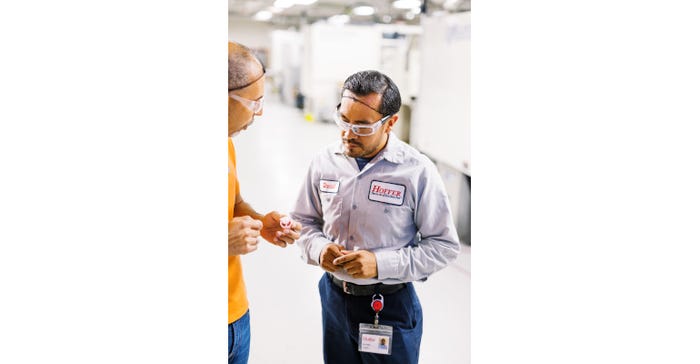Lightweighting Takes the Spotlight
More industries are looking for sustainable plastics solutions that can help support lightweighting initiatives.

Facing unprecedented pressure to create a smaller environmental footprint, companies are in a race to reduce the amount of plastic used in products and applications everywhere. From automotive to aerospace to medical to consumer goods to packaging and beyond, lightweighting is at the center of nearly every design conversation. Why? It’s a solution that can improve product performance and safety, increase energy efficiency, reduce manufacturing costs, and create greener products, all under the increasingly popular moniker: Less is More.
Most simply defined, lightweighting is the process of removing weight in three seemingly simple ways: substituting lighter materials for heavier ones, optimizing designs to remove weight, or eliminating materials altogether. However, the conversation gets significantly more complex from there.
Ensuring product strength, functionality, manufacturability, and even consumer preferences raises a myriad of considerations for reducing weight. Material specification and performance, part and wall thickness, gate locations, and shrinkage are among a long list of specifications. All are critical to creating a clear pathway to repeatable manufacturing and the cost-effective, on-time delivery of high-performing parts.
Manage Complexities With a Holistic Approach to Lightweighting
Regardless of your industry, taking a holistic approach to lightweighting can help eliminate and manage the complexities associated with these initiatives. In our experience, the five steps outlined below will make your journey more successful and much easier.
Establish clear goals.
Properly weigh functionality and aesthetics.
Don’t overdesign your part.
Choose the right manufacturing partners.
Begin with your highest payback products.
Establish Clear Goals
The first step in any well-designed process is to establish and articulate goals. Remember the wise words from baseball legend Yogi Berra: “If you don’t know where you’re going, you’ll end up someplace else!”
These three goals illustrate the differences in approach that each will drive inside your organization.
Goal: Reduce Product Weight
For many product manufacturers, lowering weight is the primary and sometimes singular driver of this initiative. Reducing the weight of cars is critical to improving fuel efficiency. Lowering the weight of household goods is critical to usability and avoiding the fatigue of carrying heavy products. Done well, these lightweighting initiatives should also deliver ancillary benefits like improved functionality and durability through the utilization of higher-performing, lighter-weight plastics.
Goal: Eliminate Cost
Driven by the need to reduce program costs and pass those savings to customers, lightweighting—from this perspective—must simultaneously lower material usage while taking cost out of the manufacturing process. To accomplish this goal, a strong product design team will look at how to combine multiple features into fewer components, taking weight out while simplifying design—without compromising the structural integrity of the part and the important features that maintain end-user and process safety. This, in turn, reduces tooling costs, eliminates secondary operations, and significantly lowers material waste.
Goal: Create a Greener Solution
Study after study indicates the importance of environmental preservation to end users across markets. Lightweighting presents a real opportunity to achieve environmentally focused goals. Lowering the volume of plastic in your products reduces end-of-life disposal issues. It also streamlines your resource usage—from energy consumption to fuel usage for transportation. It can improve profitability through lower scrap rates and manufacturing costs. And perhaps most importantly, it will build your company’s brand reputation—helping to attract both customers and employees.

Properly Weigh Functionality and Aesthetics
While functionality and aesthetics are both important to successful product design, a common misstep in lightweighting is the prioritization of aesthetics over functionality. Focusing first on product performance will ensure the design of superior products with optimized performance. This approach also helps to avoid issues with manufacturability that can negatively impact functionality, productivity, and delivery long term.
Focusing on functionality first and aesthetics second in product design can also expose new opportunities to eliminate or replace unnecessary structures and features that do nothing but simply add weight to your final product. Further, you can do so without sacrificing safety—of the product, end users, manufacturing processes, and more.
By creatively seeking opportunities to balance these considerations, designers can produce the strongest outcomes for their customers. For example, in the consumer goods market, where lightweight, flexible pouches are already widely in use, opportunities to lightweight rest mainly in caps and closures. While aesthetics are often vital to maintaining brand reputation, most important is the cap’s twist-off functionality, seal integrity, and safety features that solidify flexible pouches as the right format. With the right balance of functionality and aesthetics, one solution uses 20% less resin to reduce weight and cost while increasing sustainability for CPG producers.
Avoid Overdesigning Your Part
Instincts often tell us to be as thorough as possible when designing—or redesigning—a product and its components. However, when looking at component design, it is easy to overdesign, leading to complications in material selection, manufacturability, and product performance. Finalizing design parameters—like materials, critical tolerances, gating, and more—can lead to potential missteps that could be avoided with the right team.
Product designers can overcome missteps by collaborating with their manufacturing partners early in the process. The right material supplier can offer insights into material selections that can optimize form, function, and even the environmental impact of your products. The right contract manufacturer can advise you on issues that span from higher-than-necessary tooling costs to issues with design for manufacturability (DFM) to potential assembly concerns to lower product performance in use. Bringing the right partners to the table early in the design process can help you accomplish your primary objectives more quickly while avoiding the challenges that complicate rather than simplify good design.
For example, a leading consumer goods company was manufacturing a component of a popular product through a process that required three separately injection-molded parts to be welded together to create the final component. While this process produced a functioning part that proved successful in the market, there were opportunities to refine the process to decrease costs with a different process. Through collaboration with a larger team, including its contract manufacturing partner, the team reconfigured the design and the process to mold the component in one piece. This eliminated secondary options while greatly improving product function and quality.
Choose the Right Manufacturing Partners
Even the most experienced design teams benefit from the specialized expertise of material suppliers and contract manufacturers. When navigating the complexities of lightweighting, bring teams with varied perspectives to the table to achieve your primary goals, spur innovation, and realize the full benefits that lightweighting has to offer.
To foster creativity and innovation, look for partners who can bring ideas to the table you may not have previously considered. Their experience in technologies like gas-assist injection molding to produce thin-walled parts, or in low-density polyethylene materials known for low-temperature flexibility, toughness, and corrosion resistance, can open design considerations that will elevate your products, your company, and your brands.
Strong two-way communications are fundamental to success, which brings us back to the very first point in this process: clearly articulate your goals. An understanding of your goals, how a specific component needs to perform in-application, or the ‘why’ behind a particular specification or geometry will make sure teams are aligned and collaborating to achieve more together than they can individually.

Begin with Your Highest Payback Products
Brands, manufacturers, and end users alike have benefited from lightweighting for many years. With the right goals, priorities, design, and partners, lightweighting can be an important consideration across a broad range of products and applications. That’s why it’s important to identify and chart a path for your highest payback products.
Begin by asking yourself these questions:
What products am I working on that represent a new design opportunity?
What programs are ahead of me where lightweighting has the potential to make a real, measurable impact?
What customers or teams am I working with who will clearly see the benefits?
What material and manufacturing partners can I assemble with the expertise I need to win?
What team members are passionate about this and will join me on this journey?
The answers to these questions will help pinpoint where to begin and will start this important dialogue in your company or on your team. Like all journeys worth taking, the first step is often the hardest, yet most important one to take. But in the end, lightweighting will take you down an important path to charting a course with better outcomes for your company, your customers, and the world we all share.
About the Author(s)
You May Also Like







